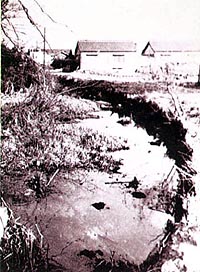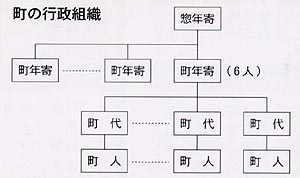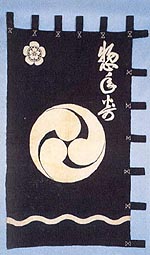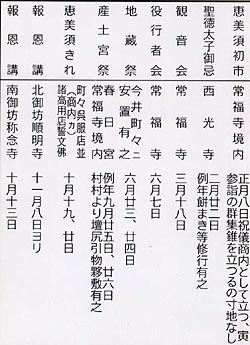寺内今井の誕生
「今井」が初めて文献上登場しますのは、興福寺一棄院文書で、至徳3年(1386)、興福寺の荘園としてです。
室町時代の後期には、この付近に一向宗(浄土真宗)の道場(後の称念寺)がでさ始め、旧勢力に何回か焼さ払われますが、天文年間(1532〜55)頃には、寺内が誕生していたと考えられています。
Origin of imai-cho
During the latter half of the Muromachi Era
(1333-1568), the lkko Sub-sect of the Jodo Shin
Sect of Buddhism erected a hall in lmai for as-
cetic practices (now Shonenji Temple). Al-
though the hall was burned down several times
on orders from Kofukuji Temple, it was rebuilt
each time. By the Temmon Period (1532-1555),
ajinai-cho (a town within the precincts of a tem-
ple) had already formed around the hall.
市街地の形態
寺内町今井は、中世の環豪集落を母胎とし、天文年間には東西南北の四町がでさ、その後、
新町、今町が整い、文禄検地の頃には、六町が成立していました。周囲に掘(約3間)及び土
居をめぐらし、九つの門がありました。
Town Configuration
During the Temmon Period, Imai's jinai-cho comprised East,West, South and
North
Districts. Two additional districts (the Shimmachi and lmamachi Districts) then devel-
oped before the Bunroku Period (1592-1595). At that time, the town was surrounded
by a moat (about 5.5m wide) and mounds with nine gates.
石山戦争と今井
元亀元年(1570)大坂石山本願寺は、織田信長軍に攻撃を開始します。今井では今井兵部のもと・町を武装化し参戦しました
が、天正3年(1575)に織田信長から赦免されています。その後、武装を解除して在郷町として発展をみます。
Ishiyama Uprising and Imai
In 1570, Ishiyama Honganji Temple in Osaka began attack-
ing the army of Oda Nobunaga, one of the strongest feudal
lords. Under the leadership of lmai Hyobu, residents of lmai
participated in the uprising. ln 1575, however, Imai's leaders
decided to surrender to Nobunaga's army. After disarming it-
self, lmai began to develop as a rural town.
寺内町とは、
中世の終わり頃、浄土真宗本
願寺派などの寺院の境内地にき
ずかれた集落で、寺院の四周に
掘をめぐらせ、土居をきずいて
いるのが特徴です。当時は、裁
判や諸公事などで独自に町を運
営していました。税制面などの
経済的特権が認められて、多く
の庶民が移り住みました。
一向宗とは、
鎌倉時代、親鸞聖人が開いた
「浄土真宗」の教えを受け継ぐ
宗派。親鸞の没後、八世法主蓮
如上人の時、庶民層にもわかり
やすく教えを説さ、信者がふえ
ました。大坂石山本願寺を中心
に広い範囲に拡がりました。


今井町の移り変わり(development of Imai-cho)
地図をクリックすると拡大します。
今井町の旧環濠(moot)
寺内町分布(map jinai-cho)
地図をクリックすると拡大します。
写真をクリックすると拡大します。
織田信長今井郷惣中宛赦免状
(letter from Oda Nobunaga)
自治都市・今井
江戸時代の今井は、幕薯体制下で、郡山蕃等に入っ
たこともありますが、約180年間は天領でした。し
かしなから、自治の気風は強く、大幅な自治的特権
が許されていました。町政は、今西、尾崎、上田氏
の惣年寄を中心に組織され、司法・警察権の一部を
握っていました。また、町民自らか「町掟」を定め
て社会のルールをつくっていました。
Imai as a seif-governing Town
During the Edo Era (1603-1868), Imai was
governed directly by the Shogunate Government
for 180 years. Owing to the town's inherited
spirit of autonomy, however, Imai's citizens
were granted a considerable degree of self-
government. Senior town officials, who had
some judicial and police powers, came from the
lmanishi, Ozaki, and Ueda families, and the
town's regulations were determined by resi-
dents.
商業都市・今井
今井には、近在から多くの商人が移り住み、赤らゆる商売が行われ、なかでも繰綿・
古手・木綿を中心に多いに栄えました。その中から豊かな財力を貯えたものも出て、
両替商を営み、大名にも金銀を貸すものもあらわれました。寛永11年(1634)には「今
井札」の発行が幕府から許可されたほどでした。このように最盛期のにぎわいは、い
くつかの俚謡や民謡からもうかがわれます。
「大和の金は今井に七分」
Imai as a Commercial Town
Imai attracted many merchants dealing in a wide variety of products, particularly
unrefined and refined cotton, and secondhand articles. Some merchants became
extremely wealthy and began lending money even to feudal lords. In 1634, the
Shogunate Government allowed lmai'to issue paper money. A popular song of the
time said that in lmai, you could find 70% of all Yamato's money. (The former
Yamato province is now Nara Prefecture.)
今井の文化
江戸時代初めには、家数千軒、人口
4干に達する程の繁栄をみましたが、
町民は、町掟等によって自らを規制し
て窮屈な生活を送っていました。特に、
火災については厳しく定められていま
した。日待講や地蔵講などの宗教行事
は、唯一の楽しみでした。特に氏神春
日神社の祭礼でのタンジリは豪壮なも
のでした。町衆文化も発達し、茶道、
華道、能楽、琴、書道、和歌などが盛
んでした。
Resident's Daily Lives and Culture
In the beginning of Edo Era, Imai
flourished, having thousands of
households (population of 4,000).
Despite their economic prosperity,
Imai's residents imposed strict rules
on their daily activities, and led sim-
ple and frugal lives. Particularly
strict rules were imposed in order to
prevent fires. Residents worked hard
throughout the year, except for relig-
ious event days. (the festival of
Kasuga Shrine, when magnificent floats
were brought out.) Wealthy merchants
enjoyed tea ceremony, flower arrangement,
and so on.
今西家内部(広い土間では簡単な裁きが行われた)
Imanishi House(interior)
写真をクリックすると拡大します。
惣年寄旗(上田家蔵)
(frag Ueda)
今井町明細記(原文)より抜粋
(Imai's event list)
秋祭りのだんじり
(magnificent fioats)
銀札(銀1)、今井札(銀1)、銀札(銀2)
(Imai paper money)
資料提供及び取材協力
:橿原市教育委員会
:橿原市観光協会
今井の町家
今井町の伝統的様式の町家は、切妻造、平入、前後庇付本瓦葦(または、
桟瓦葦)が基本です。内部は、片側を通り土間とし、片側は床上の居室部と
なっています。正面からみると、出入口を大戸構えとし、前面に様々な意匠
の格子をはめ、上方「つし二階」にはむしこ窓をあけています。
現在でも、伝統的な町家が6割を占め、そのうち6割が独立型、4割が連
続型で人々がすんでいます。
今西家をはじめ、8件が重要文化財、4件が県指定文化財、6件が市指定
文化財になっています。
Merchant's Houses in Imai
A typical merchant's house in lmai features a gabled, tiled roof with
eaves on both sides, running parallel to the street. The house is roughly di-
vided into two sections: a "doma,"which had a compacted earthen floor, on
one side, and rooms on the other side. Viewed from the street, the house has
doors and windows with elaborate lattice designs, and "mushiko"window.
Today, 60% of the houses in lmai-cho are traditional merchants' houses;
of them, 60% are separate houses and 40% are terrace houses, both used as
dwellings. Eight traditional houses, including the lmanishi residence, are
designated Important Cultural Properties by the national government; four
are prefectural cultural properties; and six are municipal cultural proper-
ties.
町並みの表情・意匠
掟や御触れなどで、町家の造りは、厳しい規制がありましたが、町民たち
は、その中で個性的なデザインを生み出しました。屋根の煙出し、鬼瓦、む
しこ窓、壁面の意匠、「しもみせ・みせのま・みせおく」前面の様々な格子、
出格子、駒つなぎ等、町民の美意識を感じます。
Architectural Designs
Since strict regulations controlled architecture in lmai,
residents demonstrated their aesthetic sense by elaborating
the design of such details as smoke-exhaust windows on
roofs, ridge-end tiles with a gargoyle like design,"mushiko"
windows, wall designs, various kinds of latticing in win-
dows and doors,and horse hitching-rings.
都市化との共存
今井町で町並みを守る運動がおきたのは、昭和30年頃です。昭和40年代に
は、全国的に大さな流れの中で、今井にも住民組織が結成されました。昭和
50年〜60年代には、住民と行政が一体となって、今井町のまちづくりの視点
で調査や話し合いをくりかえすとともに、建物の修理、修景補助事業や歴史
を生かした道路整備を実施しました。また、各種イペントや地味な活動によ
り、平成5年には、重要伝統的建造物群保存地区に選定され、歴史的な町並
みを生かした「まちづくり」を進めています。
Preservation Movement
Around 1955, town preservation campaigns arose in lmai-cho. After
1965, residents began forming grassroots organizations to this end. Be-
tween 1975 and 1988, the town administration held discussions with resi-
dents, and launched such projects as architectural restoration, landscape
enhancement, and the construction of roads emphasizing the historical
landscape. In 1993, Imai-cho was determined a Preservation District for
Groups of Historic Buildings, as a result of various grassroots activities and
related events.



